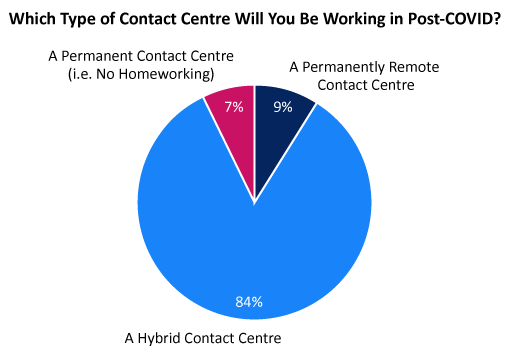Comdata discuss the future of working from home and what that means for customer management.
Working at home wasn’t actually new in 2020. Way back in 1979, IBM allowed a small group of Silicon Valley employees to work from home, complete with hefty 70s-style computer terminals.
By the early 2000s, many of the big names in US tech had a large proportion of people ‘telecommuting’ – until several of them backtracked in the 2010s and decided that people would be more productive back in the office.
Then came COVID-19, and a mass exodus from the office by anyone who could work more safely from home. The big question for all of us now is whether this shift is structural – the new normal or a temporary trend that fades post-pandemic.
If work from home does become permanent, there will be significant consequences for how businesses and brands manage their relationships with their teams and their customers.
With this in mind, here are nine key points to consider as you contemplate whether the future of work lies at home or in the office.
1. Employees Want it to Continue – to an Extent
One year on, feelings about remote working are largely positive, especially since the technology available for virtual working has proved itself largely up to the task.
A study of 25,000-plus people by IBM found that over half (54%) would prefer to work “primarily remotely”, and a Call Centre Helper poll show that around 87% of contact centres would like to retain at least some element of home-working once there is the choice to go back to work.

This poll is made up of data sourced in the Call centre Helper Webinar: Contact Centre of the Future
Their reasons don’t come as much of a surprise: less time and money spent on commuting, lower housing costs, and better work-life balance.
2. But There are Downsides
When it comes to the question of full-time, permanent home-working, employees and employers are wary.
Staff miss the collaboration, creativity, socialising and learning opportunities they get at the office. Younger and early-stage employees especially miss out on mentoring, networking and learning opportunities.
There’s no firm view on whether home-working has affected businesses’ productivity negatively or positively – there is research pointing to both. Even those who have seen short-term benefits from the work from home migration worry about longer-term effects on innovation and performance.
And of course some jobs will not shift to home-working. An analysis of UK working patterns – by Consultancy.eu – found that 52% of staff cannot work remotely, even for a day, due to the nature of their work – whether it’s in transport, health and care, manufacturing, utilities, hospitality, leisure or other sectors.
The study concluded that post-pandemic, around one third of work in Europe could be done remotely.
3. Much of What Businesses Know may Need to Change
If one third of the workforce makes a structural shift to home-working, employers will have to figure out new ways for staff to learn, share knowledge, collaborate, innovate, and connect with each other.
Otherwise, they could see adverse effects on employee engagement, staff turnover, and productivity.
They will also need to review their physical footprint. If offices are going to become places for collaboration and meetings, rather than desk-working, businesses will need less space overall but will need to design that space to foster teamwork, social connections, creativity and learning.
4. But Their Labour Shortages Could be Solved
One very strong argument in favour of a structural shift to remote working is that it will help solve some of Europe’s labour market problems.
By 2030, over a third of Europe could live in places where jobs are declining – according to McKinsey Global Institute – forcing young people or families to move away to find better opportunities.
At the same time, there are cities such as Paris, Amsterdam, Madrid, Milan, Munich and London where living costs outstrip many people’s income levels, causing a risk of labour shortages and skills gaps.
A long-term shift to remote working could mitigate these problems. Businesses could tap into a broader talent pool, and reduce their need for expensive city-centre office space; people in declining regions could find new employment opportunities.
5. A Shift to Remote Will see a Shift to Digital
A migration to remote working will also change how people shop, spend and engage with businesses.
We already saw this in 2020. There were increases in sales of consumer electronics, home cooking appliances and loungewear, energy bills rose, and, of course, e-commerce usage soared.
In a KPMG ‘pulse’ survey of 75000 consumers in 12 markets in late 2020, 45% predicted digital channels would be their main way of contacting brands in future.
There are huge opportunities for brands to differentiate themselves through the use of video, social media, email and messenger apps for digital customer management.
6. Customer Loyalty is There to be Won or Lost
The shift to digital interaction rather than physical interaction can be a significant inflection point in customer loyalty.
In sectors from banking to energy to media to retail, brands will have to adapt to rapidly evolving consumer expectations and customer demands, and build trust with existing customers as well as new ones.
Influences on customers’ purchasing or loyalty decisions are likely to include:
- ease of interaction through channels that suit them – from email to phone to WhatsApp
- online customer experience (CX) – from seamless resolution of problems to replication of the personalized in-store experience
- growing awareness of alternative providers online, through search or word of mouth
For all brands, this offers both challenges and opportunities. They’ll have to work hard to maintain loyalty with existing customers, but they’ll have new opportunities to win customers.
Customer management and digital CX will be key to success on this.
7. Data-Driven Businesses Should Thrive
The advantage of the shift to digital is that businesses have more data than ever before. They know:
- Who bought from them
- Who browsed but didn’t buy
- At which point of the purchasing journey they dropped out
- Who came back to browse again etc.
To make best use of this data requires excellent analytics and AI capabilities. Smart businesses will use data from all their touchpoints to better understand and predict customer behaviour and improve their customer journeys.
But it’s easier said than done, and many businesses don’t yet have these capabilities in-house.
8. But the Human Touch is More Important Than Ever
Data, analytics and AI will be crucial to customer management post-pandemic, but automation won’t supply all the answers.
Some customers and purchases still rely on the human touch of a skilled agent who can personalize the experience or provide advice.
The most successful customer experience providers are combining the best of both the automated and human worlds, through “augmented” agents who can leverage elements such as bots and algorithms to supplement their own skills at understanding customer needs and converting sales.
And since these agents too may be working from home, they need to be supported to develop and deliver their skills remotely.
9. None of This is set in Stone
The final lesson for all of us is the need to stay flexible. As COVID-19 reminded us, things change. The unexpected does happen, and it can also be followed by ripple effects that create longer-lasting shifts in how we live, spend, consume or work.
So, what we know today about work from home may be different in six months, two years or five years.
Survival and success in this new normal will depend on agility – reading the landscape, understanding the changes, finding solutions, and having the operational and technology excellence to implement them rapidly.
Author: Robyn Coppell
Published On: 3rd Mar 2021
Read more about - Guest Blogs, Comdata















